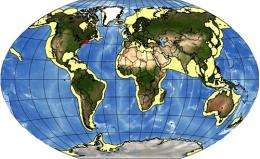Human Impacts and Environmental Factors Are Changing the Northwest Atlantic Ecosystem

(PhysOrg.com) -- Fish in U.S. waters from Cape Hatteras to the Canadian border have moved away from their traditional, long-time habitats over the past four decades because of fundamental changes in the regional ecosystem, according to a new report by NOAA researchers.
The 2009 Ecosystem Status Report also points out the need to manage the waters off the northeastern coast of the United States as a whole rather than as a series of separate and unrelated components.
Known as the Northeast U.S. Continental Shelf Large Marine Ecosystem (NES LME), the ecosystem spans approximately 100,000 square miles and supports some of the highest revenue-generating fisheries in the nation. During the past 40 years, the ecosystem has experienced extensive fishing by domestic and foreign fleets, changes in ocean water temperatures due to climate change, and pressures from increasing human populations along the coast.
Michael Fogarty, who heads the Ecosystem Assessment Program at the Northeast Fisheries Science Center (NEFSC) of NOAA's Fisheries Service in Woods Hole, Mass., says his team's report highlights the need to understand natural and human-related changes in this region and to develop effective management and mitigation strategies.
"There are many pressures on the ecosystem including fishing, pollution, habitat loss from coastal development, and impacts on marine life from shipping and other uses of the ocean," Fogarty said. "In addition, changing climate conditions are warming ocean waters, changing ocean chemistry and circulation patterns, and altering atmospheric systems. These changes have, in turn, been linked to changes in the distribution and abundance of fish species in the region and their major sources of food."
The report is the first in a planned series of ecosystem status reports by Fogarty and his colleagues in the NEFSC's Ecosystem Assessment Program to document changes in the NES LME, one of 64 regions in the world's ocean designated as a large marine ecosystem. LMEs are large coastal ocean waters adjacent to continents and characterized by distinct bathymetry, hydrology, productivity and inter-related marine populations. LMEs produce 80 percent of the world's annual fishery yields, and most of the impacts of human activities in the ocean occur within their waters.
Some of the highlights of the program's first report:
- Warming of coastal and shelf waters has led to northward shifts in distribution of some fish species and changes to a warmer-water fish community.
- The community structure of zooplankton, a major food source for whales and many other marine species including fish, has changed, due in part to climate and physical processes acting over the North Atlantic Basin, indicating the importance of winds and atmospheric circulation patterns to the function and structure of this ecosystem.
- Species-selective harvesting patterns have also contributed to shifts in the composition of the ecosystem, which is now dominated by small pelagic fishes such as herring and mackerel, shellfish species, and elasmobranchs (skates and small sharks) of relatively low economic value.
- The trajectory of regional human population size suggests that human-induced pressure on the ecosystem will continue to increase.
- The Northeast U.S. Continental Shelf is classified as experiencing ecosystem overfishing, although marked improvement has occurred in the condition of a number of harvested species. Exploitation rates, or the rate at which fish are removed from the ocean, have been significantly reduced in many fish stocks during the last decade, indicating that management measures put in place to reduce overfishing are beginning to show dividends.
"In the future, we need to continue to monitor the oceanographic, ecological, and human indicators analyzed in this report to detect any additional changes in the system. These indicators also provide important inputs to models that can be used to help guide management decisions and to forecast future changes."
Source: NOAA
















